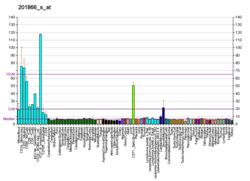
Back Receptor de glucocorticoides Catalan NR3C1 Welsh Receptor de glucocorticoides Spanish گیرنده گلوکوکورتیکوئید Persian Récepteur des glucocorticoïdes French Receptor de glicocorticoides Galician 糖質コルチコイド受容体 Japanese Receptorium glucocorticoidorum Latin Receptor de glicocorticoides Portuguese Глюкокортикоидный рецептор Russian
The glucocorticoid receptor (GR or GCR) also known as NR3C1 (nuclear receptor subfamily 3, group C, member 1) is the receptor to which cortisol and other glucocorticoids bind.
The GR is expressed in almost every cell in the body and regulates genes controlling the development, metabolism, and immune response. Because the receptor gene is expressed in several forms, it has many different (pleiotropic) effects in different parts of the body.
When glucocorticoids bind to GR, its primary mechanism of action is the regulation of gene transcription.[5][6] The unbound receptor resides in the cytosol of the cell. After the receptor is bound to glucocorticoid, the receptor-glucocorticoid complex can take either of two paths. The activated GR complex up-regulates the expression of anti-inflammatory proteins in the nucleus or represses the expression of pro-inflammatory proteins in the cytosol (by preventing the translocation of other transcription factors from the cytosol into the nucleus).
In humans, the GR protein is encoded by NR3C1 gene which is located on chromosome 5 (5q31).[7][8]
- ^ a b c GRCh38: Ensembl release 89: ENSG00000113580 – Ensembl, May 2017
- ^ a b c GRCm38: Ensembl release 89: ENSMUSG00000024431 – Ensembl, May 2017
- ^ "Human PubMed Reference:". National Center for Biotechnology Information, U.S. National Library of Medicine.
- ^ "Mouse PubMed Reference:". National Center for Biotechnology Information, U.S. National Library of Medicine.
- ^ Lu NZ, Wardell SE, Burnstein KL, Defranco D, Fuller PJ, Giguere V, et al. (December 2006). "International Union of Pharmacology. LXV. The pharmacology and classification of the nuclear receptor superfamily: glucocorticoid, mineralocorticoid, progesterone, and androgen receptors". Pharmacological Reviews. 58 (4): 782–797. doi:10.1124/pr.58.4.9. PMID 17132855. S2CID 28626145. [Free full text]
- ^ Rhen T, Cidlowski JA (October 2005). "Antiinflammatory action of glucocorticoids--new mechanisms for old drugs". The New England Journal of Medicine. 353 (16): 1711–1723. doi:10.1056/NEJMra050541. PMID 16236742. S2CID 5744727.
- ^ Hollenberg SM, Weinberger C, Ong ES, Cerelli G, Oro A, Lebo R, et al. (December 1985). "Primary structure and expression of a functional human glucocorticoid receptor cDNA". Nature. 318 (6047): 635–641. Bibcode:1985Natur.318..635H. doi:10.1038/318635a0. PMC 6165583. PMID 2867473.
- ^ Francke U, Foellmer BE (May 1989). "The glucocorticoid receptor gene is in 5q31-q32 [corrected]". Genomics. 4 (4): 610–612. doi:10.1016/0888-7543(89)90287-5. PMID 2744768.
© MMXXIII Rich X Search. We shall prevail. All rights reserved. Rich X Search







